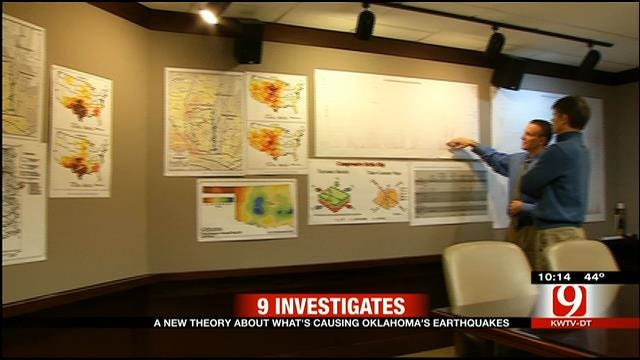A New Theory About What's Causing Oklahoma's Earthquakes
It's been a shaky last week here in central Oklahoma, following on the heels of a shaky last year -- a record-breaking year, in fact.Friday, February 21st 2014, 10:54 pm
It's been a shaky last week here in central Oklahoma, following on the heels of a shaky last year -- a record-breaking year, in fact.
According to the Oklahoma Geological Survey (OGS), there were more than 2,800 earthquakes in Oklahoma in 2013. That's twice the previous high, established in 2011.
The vast majority of the earthquakes aren't strong enough to be felt, much less cause any damage. However, enough are felt and do cause minor damage that more and more Oklahomans are clamoring for an explanation as to their cause.
Joe and Mary Reneau, who live near Prague, certainly have a passing interest. Their home was devastated in November 2011's 5.6 magnitude earthquake in Prague.
"Every corner of the house, every corner of every room was fractured," said Joe Reneau.
Since then, the couple has read everything they can about Oklahoma's earthquakes
"I think we deserve to know what's causing this," Mary insisted.
Seismologists have been studying the quakes and have offered differing theories about what's happening. There does seem to be general consensus that oil and gas activity is playing a role in the increased seismicity, but no one can say just how big a role.
One researcher, a Tulsa geologist, is now suggesting something else may be at work -- the weather and aquifers.
"Where these quakes have occurred," explained Jean Antonides, "they all have occurred around these aquifers."
Aquifers are essentially underground reservoirs -- a body of permeable rock, through which water can pass easily. There are many in Oklahoma, and the amount of water they contain can be affected by both weather and human activity.
Antonides says his research shows that aquifers near the location of certain earthquakes had been depleted, through both drought and increased human demand, and then suddenly refilled, through intense and heavy rains.
"When you have rainfall amounts of six inches over a few day period," Antonides pointed out, "these rainfalls cover a thousand square miles -- that's a lot of weight."
That much new weight – potentially trillions of tons -- if it's along or across a fault, can be enough to cause an earthquake.
"If you change the weight, relative near surface, across that fault -- either reducing the weight on one side, loading up the other side or vice versa," Antonides explained, "that could be the trigger point."
Antonides' paper lays out evidence that this hydrologic loading could have triggered, not only the Prague earthquake, but last April's 4.3 magnitude quake in Luther, a 5.8 M quake in Virginia in 2011, and others. University of Oklahoma research seismologist Austin Holland says he may be right.
"I think, in some cases," Holland told us, "there's really strong evidence that hydrologic loads can trigger earthquakes."
Holland himself theorized the weight of the extra water in Edmond's rain-swollen Arcadia Lake last summer may have caused the earthquakes that rattled Edmond in the fall.
"I find it difficult to comprehend," said Joe Reneau.
The Reneaus don't claim to be experts, but, like many, they're convinced the quakes are somehow tied to increased oil and gas activity.
"And that this new theory about the aquifers," said Mary Reneau, "is just the oil and gas companies' way of diverting attention from them to something else."
"A lot of us take offense at that," said Antonides.
Antonides does work for an oil and gas company -- New Dominion -- but says his theory is based on real science and real data.
"The key is putting everything out there, and looking at all the possibilities," Antonides insisted.
On that point, he and the Reneaus are in agreement.
"By putting it out there," said Joe Reneau, "all the other experts will have their opportunity to question it, examine it, and reach their own conclusions."
More Like This
February 21st, 2014
April 23rd, 2025
Top Headlines
April 26th, 2025
April 26th, 2025












